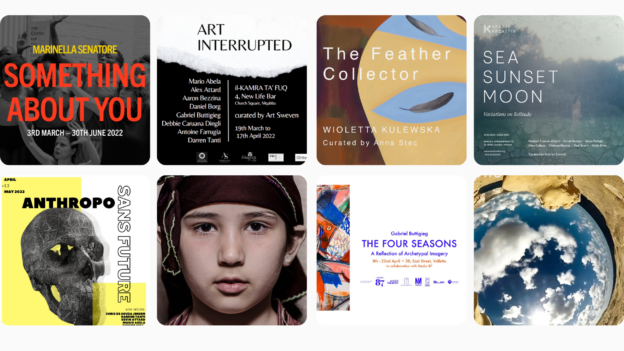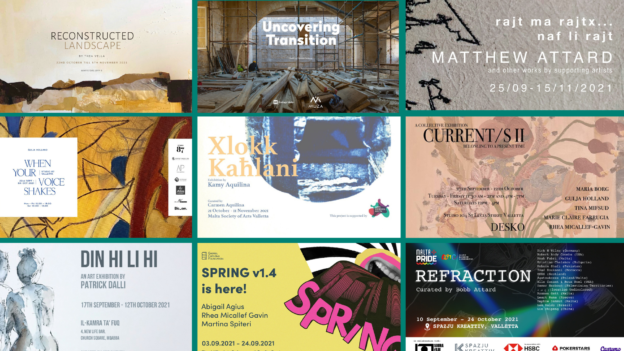In conversation with Emma Fsadni about her ongoing exhibition ‘Conditioned Comforts’

We reached out to Emma Fsadni about her first solo exhibition ‘Conditioned Comforts’ being exhibited in Space C at Spazju Kreattiv, curated by curator Margerita Pule’. Emma speaks to us about this collection, it’s meaning and processes used.

‘Conditioned Comforts’ will be your first large-scale solo show. Can you tell us about the thinking, making and preparation processes that led to the body of work that will be exhibited (change to is exhibited)?
This body of work has been a long time coming. I would say a good way to summarise the process and work as a whole is — layers. The term ‘Conditioned Comforts’ originally came to fruition as I started to take an interest in the way human-made forms of comforts influence this contemporary generation’s quality of life. The focus on human-made quickly shifted from its literal materialistic sense, to extending the notion of ‘human’ to the ‘self’, something self-made. The juxtaposition of the two words ‘Conditioned’ and ‘Comfort’ together suggests that these familiar forms of ease are acquired through repetition making them un-innate. This led to the question; if the pursuit of such comfort has to be produced or learnt, then just how comforting is it to our lives?
A process of research, conversation, reflection, analysis, experimentation, collage, visualisation, producing, emotion and refinement lays under each work. I think the most significant work in terms of process for me is the work ‘Excess’, it consists of 320 worn down painted a5 paper panels. Each piece required a preparation of four layers of glued sheets, one layer of pink paint, followed by a muddy wash of paint that is featured in a number of other works – representing a haze of uncertainty our comforts are often distracting us from. Each panel was then eroded by hand using sand paper. The aim was to represent how when our conditioned comforts are over-exhausted, despite an air of uncertainty being scratched ‘away’, the foundation beneath is left withered. I had a helping hand with some of the preparative steps, however, the wearing process was down to my own will. On a personal note, this labouring process was a key component to the work’s value as it functioned as an engrained reminder on how anything that is over exhausted, whether good or bad, will not serve oneself in the long term.

For this project, you interviewed friends and colleagues whose insights found their way into your work. How did these conversations contribute to your own artistic process?
These conversations started a discourse around term ‘Conditioned Comforts’ in concept, but also in experience. This process allowed the terms’ definition to be expanded and subsequently concentrated. It gave the phrase insight, narration and depth, unveiling individualised experiences with such forms of comfort. The comforts expressed varied from one individual to the next — it became clear that there was a present consistency in the way said comforts were interacted with. It was the relationships fostered towards the comfort, rather than the comfort itself, that struck interest and set the foundation for this body of work’s development.
The interviews also opened me up to the constructive side of such comforts. Going into this project, I deemed conditioned comforts as something that merely held one back. When put in conversation, it became apparent to me that it’s more about creating awareness around the conditioned comfort rather than canceling their existence completely. Once awareness is cultivated, one can approach one’s conditioned comforts with an air of mindfulness. For some, that may mean retrieving to it a few times less than usual, maybe adding a social component — for others, it may be cutting it out completely. It’s about recognising the familiar ‘comfort’, yet establishing and FEELING a knowing beyond it. This perspective is what triggered the final installation titled ‘Happy Medium’ — a tent like structure reminiscent of forts one would often create during one’s childhood. The installation hangs loosely, embraces flow, it embodies a sense of safety, whilst simultaneously remaining open to its surrounding energy through a sheer choice of fabric and open front.






What should the viewer expect to see? How do the works that will be shown build on and depart from previous projects?
In correlation to previous projects, this body of work continues to root from my instinctive pull towards social/self conflicts present in our contemporary state of being. Although still sticking to a minimal aesthetic, this body of work represented shifts towards more of a formal visualisation, which I had only just started tapping into in recent collective exhibitions ‘Current/s’ at Desko and ‘Unwoven’ at The Mill. Formal elements such as colour, texture, pattern and composition, abstract human behaviour and experience tied to the theme.
The expansive space and light present at Spazju Kreattiv (SPACE C) got me exploring larger scales and immersive installations — desiring to transcend viewers into a self-reflective state. Although a solo exhibition, I collaborated with a number of other creatives on this project; poetic writings by Gabriel Lia and thematic audio by James Dingli accompany the visuals and are tailored to each room’s tone. The rocking chair installation ‘UN-‘ a creative vision originally intended to be interactive, had to be revised due to the current situation’s restrictions and was luckily modelled by Andrea Amato and photographed by Justine Ellul.
Conditioned Comforts is a visual extension of a theme that hits close to home in one way or another for most of our contemporary generation. The exhibition hosts a space to transition into awareness, towards challenging uncertainty and feeling, to then lay in sensitivity recognising the existing energy, and the strength/softness beyond it. Explore in your own time and at your own pace, no rush, just presence.





Responses